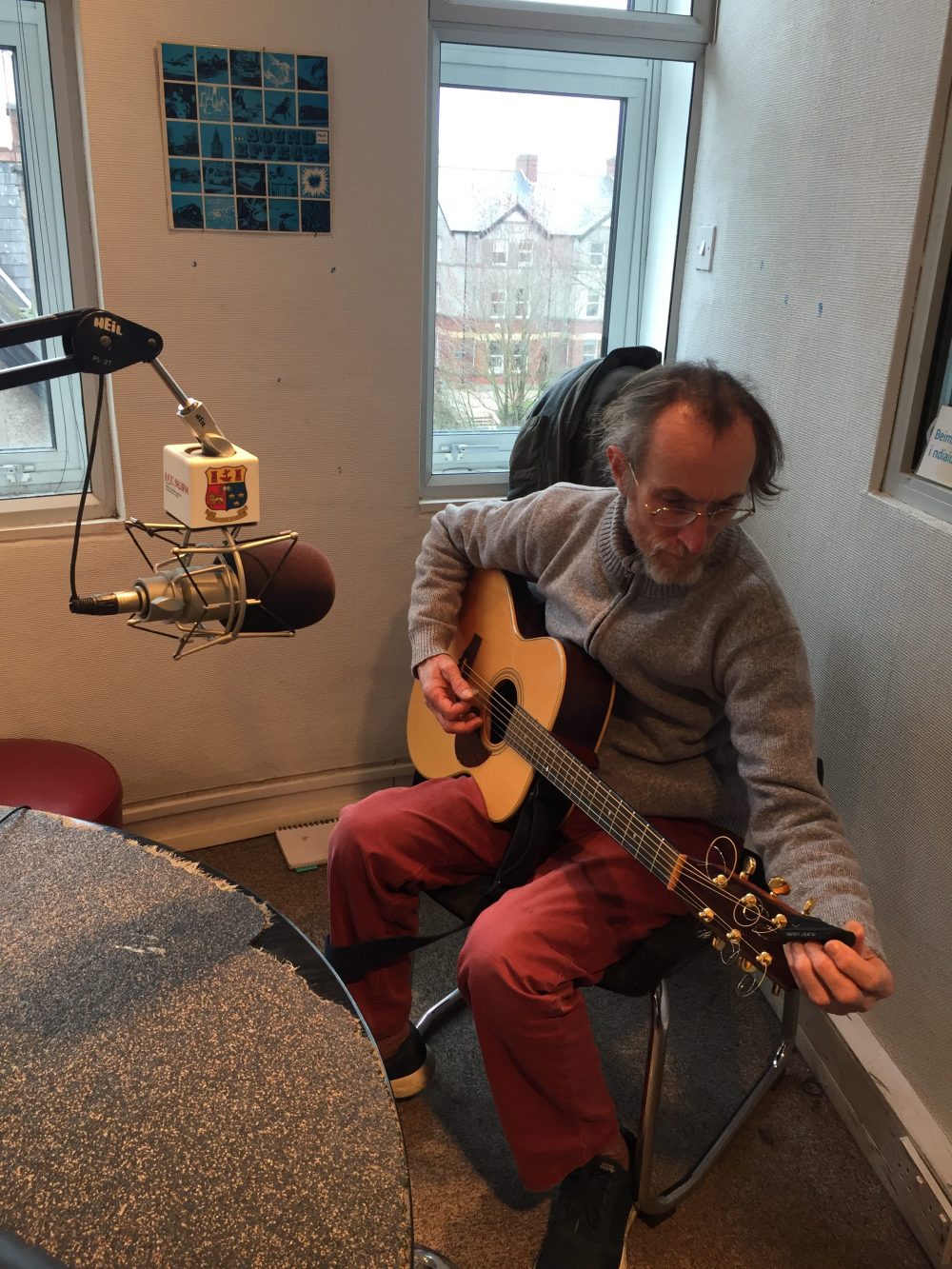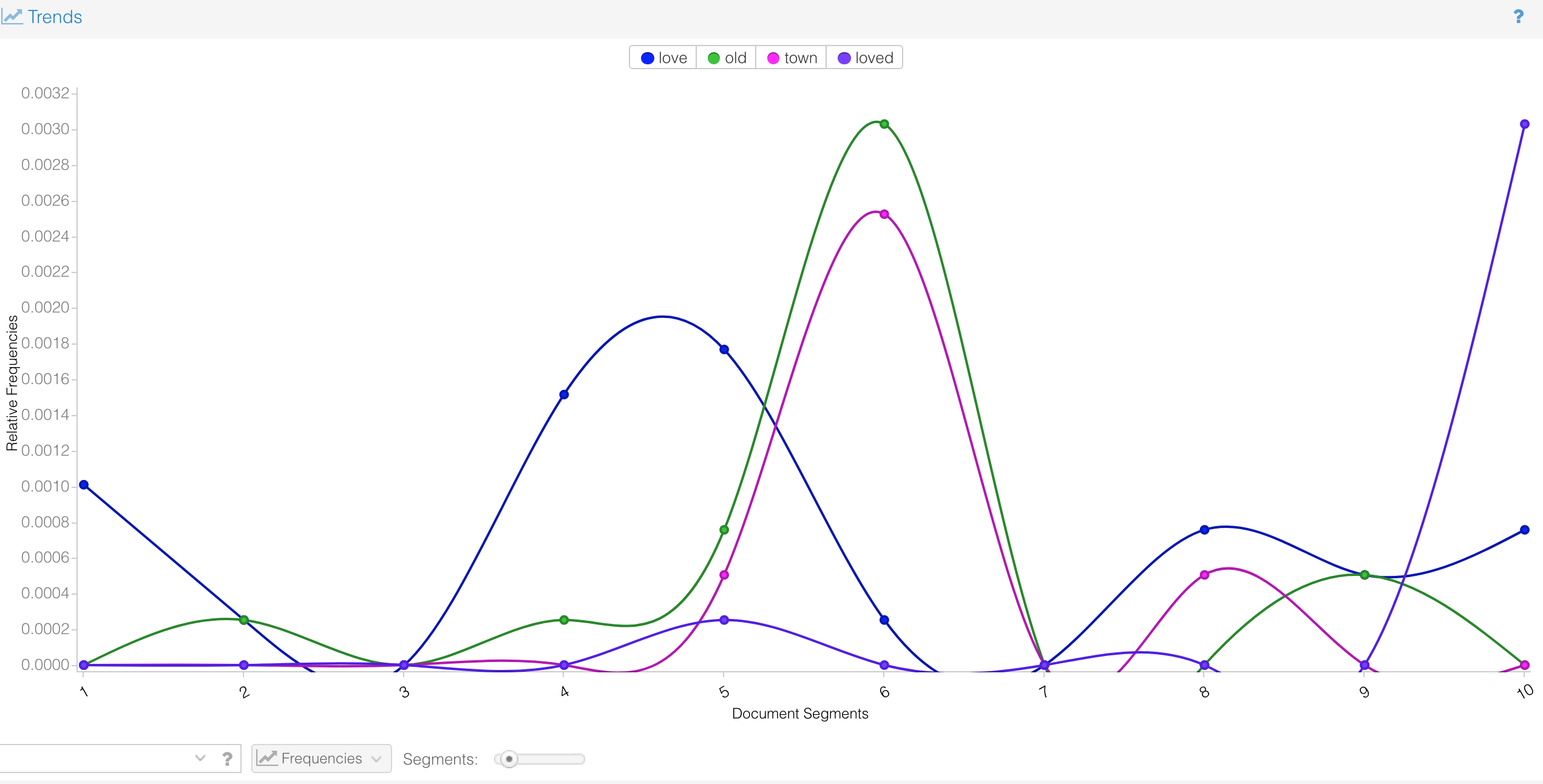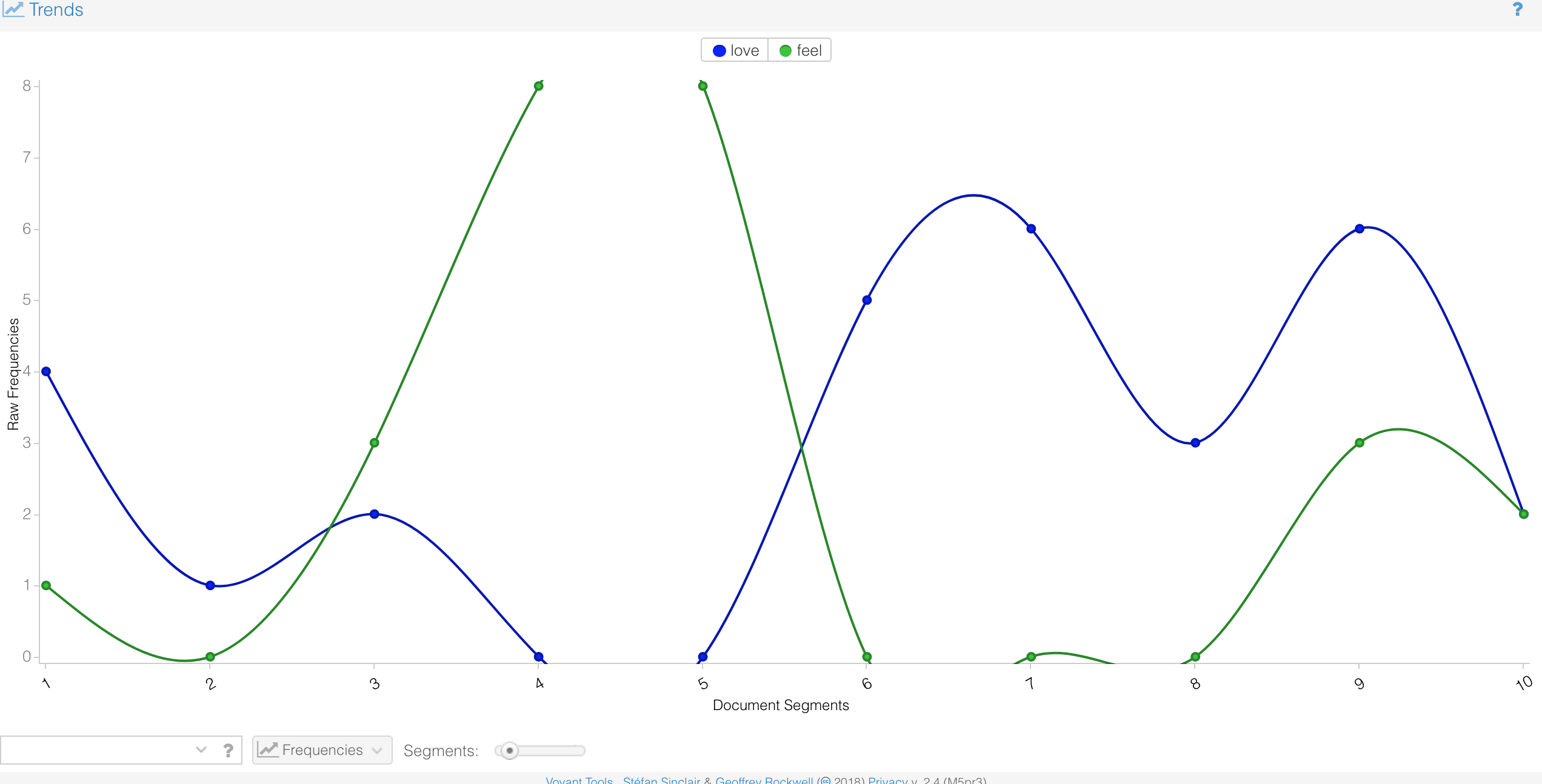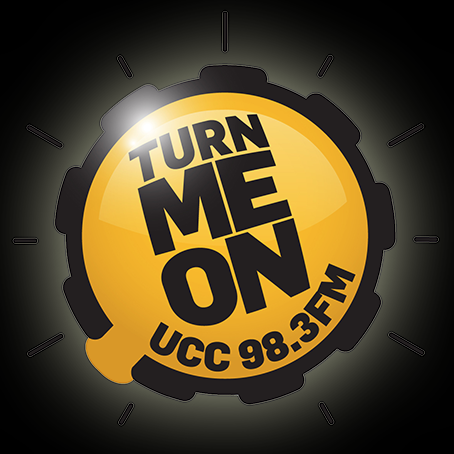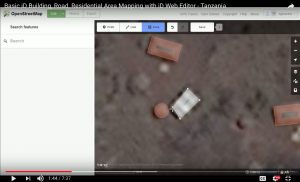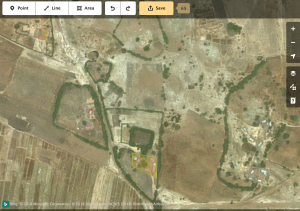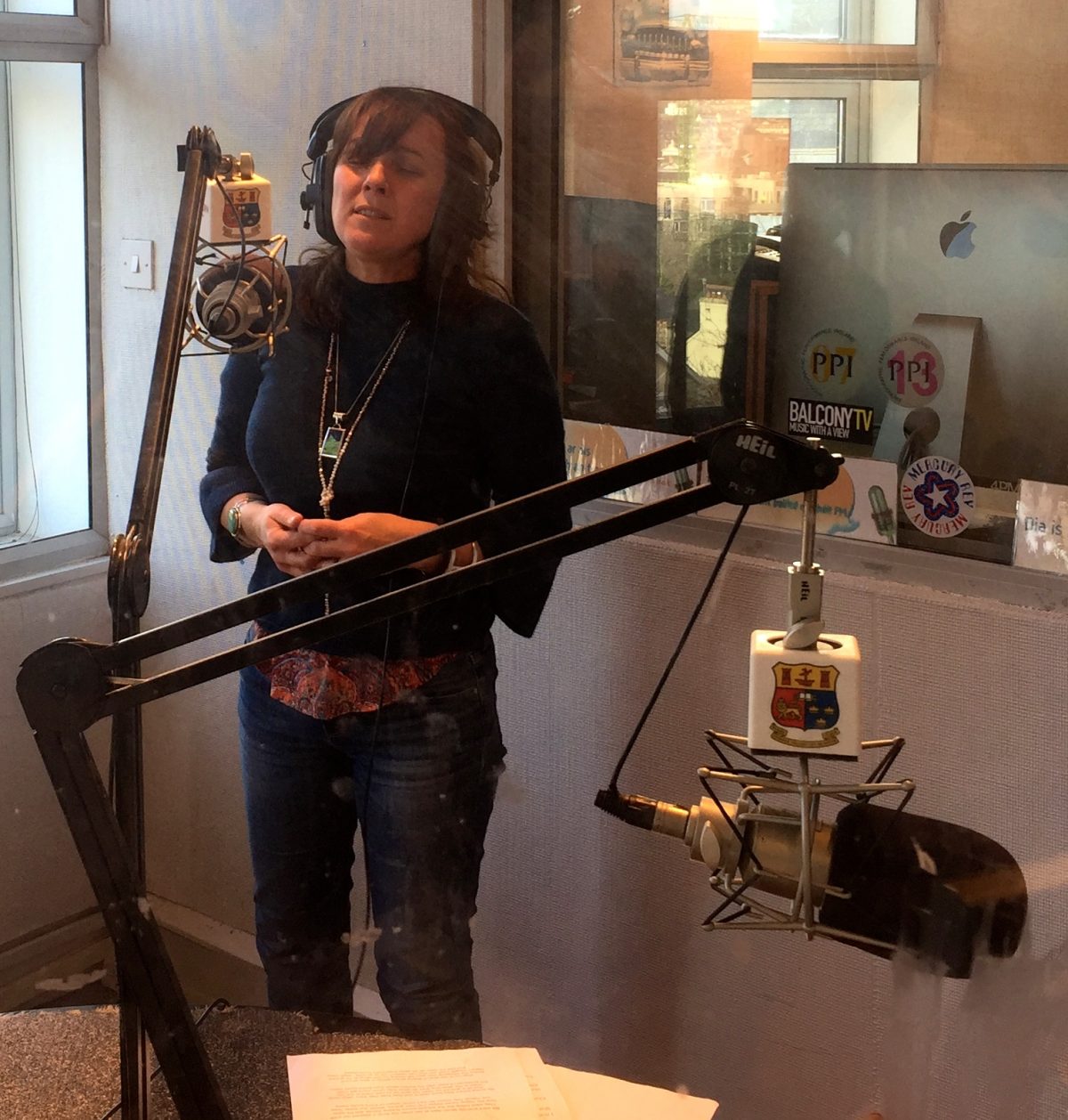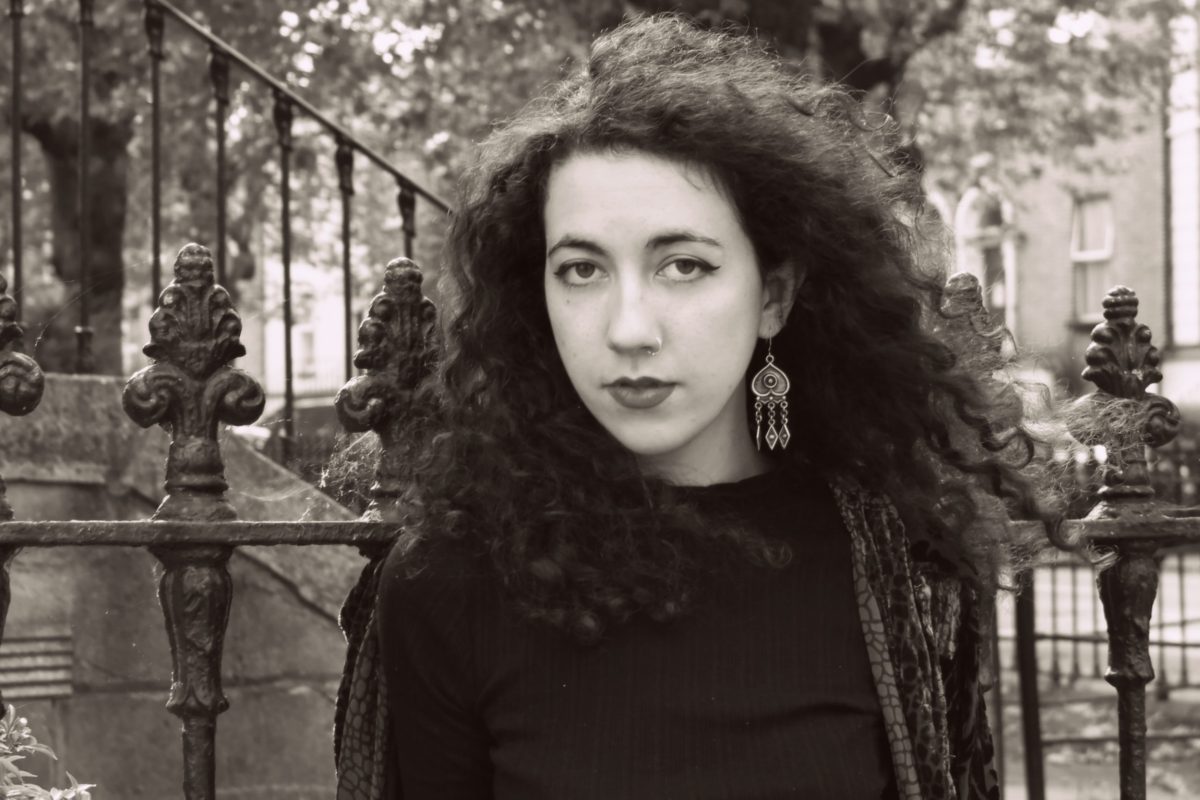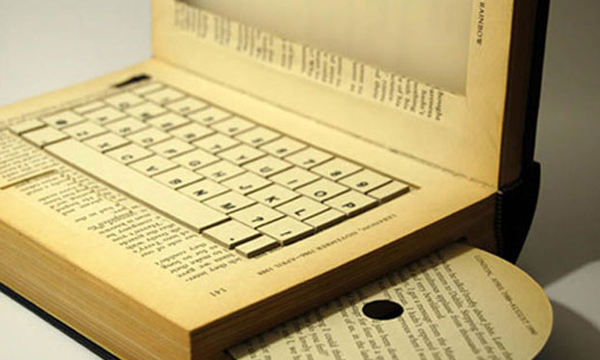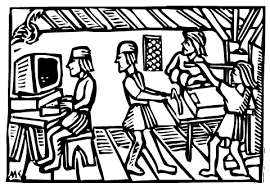This tells its own story. A date has been set in the High Court to hear 98 counts why a waste incinerator shouldn’t be built at Ringaskiddy, Co Cork. CHASE’s appeal is expensive but the community have continued to come together to raise funds and awareness. Here’s my song of support:
Tower of Song with Fintan Lucy on UCC 98.3fm
A Comparison of Popular Song Lyrics Using Voyant
Comparison of Lyrics in Popular Song
This small study compares common themes in two collections of popular songs chosen by two groups of participants in community music groups in Ireland. The two groups for the purpose of this comparison are :
- Group A: residents at a nursing home in Kerry aged 70 plus and all Irish by birth
- Group B: A mixed age & ethnicity adult education group attending a community education course at a community centre in Cork city.
Both groups worked over a period of weeks with a community music facilitator developing skills in singing together as a group. Over the duration of the course the groups selected favourite songs to sing as their repertoire. There was no pre-selection by the facilitator and the participants suggested ideas for songs from their own repertoires and backgrounds.
The purpose of the analysis in this blog is to examine these songs using a text analysis tool Voyant ,in order to see whether themes emerge from each song collection and to draw conclusions based on that information. Do the themes emerging from the two groups overlap or correlate? Does this give some insight into the commonest themes in popular song in Ireland or in popular song generally?
Each group came up with a ‘songbook’ of selected songs. In order to examine the findings it is useful to interrogate each separately and then to make comparisons. Group A’s songbook was made up of the following songs, largely traditional ballads:
GALWAY BAY
MY LOVELY ROSE OF CLARE
RED IS THE ROSE
COUNTRY ROADS
WHEN YOU’RE SMILING
KATE’S SONG
THE HOUSE OF THE RISING SUN
WHISKY IN THE JAR
WILL YOU GO, LASSIE, GO
TOORA LOORA LOORA
SALLY GARDENS
BLUE MOON
ALWAYS ON MY MIND
YOU ARE MY SUNSHINE
OH SUSANNA
DIRTY OLD TOWN
THE MOUNTAINS OF MOURNE
THE CLIFFS OF DOONEEN
WHEN I’M SIXTY FOUR
THE STAR OF THE COUNTY DOWN
THE SHORES OF AMERIKAY
SPANCIL HILL
CLARE TO HERE
NORA
COME FROM THE HEART
When the text from these songs was entered into Voyant the following word cloud result emerged:
This illustrates that the four most frequently occurring words are: chorus, love, oh and old. Already this gives some insight into common themes of the song and even into song form as it is clear that choruses occur frequently, a characteristic that might be expected in Irish songs designed for joining in and ‘sing-along’. However if we are to concentrate on themes rather than form, then the word ‘chorus’ must be eliminated and Voyant instructed to treat it as a stop-word.
This yields the following result, available as an interactive view by clicking here or on the image below
Now the most frequently occurring words are: love (27), I’m (21), old (19), oh (18), it’s (17). It is usual in text analysis to ignore pronouns but in this case it gives a useful insight. It can be assumed from this information that most of the songs in this corpus are sung from a first person perspective and that thematically they are nostalgic and romantic in nature, indicated by the references to ‘love’ and ‘old’.
As far as trends go the raw frequencies of these individual words – or tokens as they are called in text analysis – throw up some interesting information in the line graph above. Although there are clear peaks in the document where certain words are more dominant due to their prominence in individual songs such as ‘old’ in Dirty Old Town, there does appear to be a reasonably consistent occurrence of the top words throughout the songbook. This can be examined further by taking a look at relative frequencies. The word ‘loved ‘ has been included as it is a frequently occurring one (13 times) and linked to ‘love’ of course. The graph below shows that there is some trend of occurrence throughout the document even if it is not that consistent. Certainly ‘love’ is a re-occurring theme, which comes as no big surprise.
So if we draw from this analysis that the important themes occurring in songs chosen by the nursing home group are love and nostalgia, how does this compare with the songs chosen by Group B, a more mixed age and ethnic group?
The songs chosen by Group B are:
BOTH SIDES NOW – JONI MITCHELL
IMAGINE- JOHN LENNON
ANNIE’S SONG – JOHN DENVER
HAPPY – PHARELL WILLIAMS
THE HEART MUST GO ON – CELINE DION
SALLY GARDENS
RED IS THE ROSE
SOMEONE LIKE YOU – ADELE
MAKE YOU FEEL MY LOVE – BOB DYLAN/ADELE
THANK YOU FOR THE MUSIC – ABBA
Already we can see that there is a much higher incidence of contemporary music (1970’s to present) than in the previous sample group and only two traditional songs : Sally Gardens and Red is the Rose , both of which were also chosen by Group A. It is also clear that the two corpus are of different lengths which is why it is important to pay attention to relative frequency as opposed to raw, the latter giving the total number of occurrences of a word. What else can text analysis tell us about emergent themes in this second corpus?
Below is an interactive representation of the Voyant Analysis which allows the user to search different tokens and view findings accordingly. A full screen and therefore more user friendly interactive view can be reached by clicking here:
By using the search panel on the Reader section of this report it is possible to quickly see the distribution of a word’s occurrence. The word shows up highlighted in the text as well as in a line graph below. From this we ascertain that the song ‘Happy’ contains many examples of that same title word as well as the word ‘clap’ and so it makes sense to exclude these from the search and include them as stop words to avoid skewing the resulting word count frequency.
‘Like’ is also removed as it is usually used as a comparison or within metaphor. Having assessed the frequent words, it is helpful to pick ‘love’ and ‘feel’ and represent them in the graph as they appear to be the dominant ones throughout the document.
Does this text analysis offer any insight into these song themes? Love and feelings are always going to be dominant themes in popular song and so in a sense the analysis merely backs up what we already know. The fact that ‘old’ appears throughout Group A’s songbook – even allowing for the peak around Dirty Old Town- does tell us something about the nostalgic style of these more traditional songs compared to more recent songs. Both groups threw up ‘I’m’ as a high frequency word, which would indicate that most of the songs from both groups are written from a first person perspective. That offers an interesting pointer for investigating a larger corpus to see if most popular songs are indeed written as first person narrative. Casual observation would guess that they are. Does this then make it easier for people to identify with the singer/ writer and is this why people select these songs above third person narrative?
Voyant certainly offers many opportunities as a starting point for analysing textual data and in this case helps to not only discover and validate information about themes but also about song form and perspective.
Smedias 2018 Showreel Radio Production of the Year Arts & Features (montage)
Smedias 2018 Showreel DJ of the year (montage)
Mapping for Good: Reflections on Crowdsourcing & Humanitarian Open Mapping
Introduction
In this post I give a brief insight into Crowdsourcing as it is used in the Digital Humanities and also describe my experience of using three open source, crowd-sourced mapping tools:
Crowdsourcing in Digital Humanities
In her blog post on Crowdsourcing and Community Engagement Alicia Peaker quotes Enrique Estelles-Arolas and Fernando Gonzales-Ladron-de-Guevara’s definition of crowdsourcing:
“A type of participative online activity in which an individual, an institution, a nonprofit organization, or company proposes to a group of individuals of varying knowledge, heterogeneity, and number, via a flexible open call, the voluntary undertaking of a task.”(Crowdsourcing and Community Engagement)
This definition provides a fairly accurate description of the projects I recently contributed to as I experimented and explored some crowdsourced activities and open mapping for humanitarian causes.
Peaker remarks on ‘how enthusiastically public audiences respond to a well-defined project to which they can contribute through an expertly designed interface’, so my question when approaching the tasks was to see to what extent these are well designed interfaces and to what extent my response, as a new user, can be measured in terms of enthusiasm.
In the blog post Digital Humanities and Crowdsourcing: An Exploration from the Museums on the Web conference 2013 , the authors identify two main types of Crowdsourcing projects. Open Mapping falls under ‘Crowdsourcing projects that require the “crowd” to integrate/enrich/reconfigure existing institutional resources’ as opposed to ‘create/contribute novel resources’. The activity required of the crowd is ‘locating’, i.e. ‘placing given objects in physical space….. and providing information on locations’ (Digital Humanities and Crowdsourcing).
What exactly is Open Mapping ?
Open mapping is the use of open sourced street maps that allow contributors to interact with the map in a number of ways. This varies according to the mapping project and application but in Open Street Map for example a new unschooled citizen cartographer such as myself can edit features on the map, re-naming places and streets and adding and verifying new features according to local knowledge. In this way I was able to edit the map of my local area of Cork city, Sundays Well , renaming Daly’s Bridge to its colloquial name “The Shakey Bridge”,adding in the location of a lifebuoy and updating the name of a local restaurant as well as adding my favourite local café to the map.
OSM User Experience
As a complete newcomer to open street mapping I found this to be quite an empowering,fun and potentially addictive activity. Up until a few weeks ago I was not aware that there were any alternatives to Google Maps and the democratisation and non commercial ethos of open source, crowd sourced mapping appeals to me. I have always been fascinated by maps and the possibilities they present in terms of what features we may choose to display as well as the concept of deep mapping – a way of integrating many layers of information – is one to which open street mapping can open a door.
However, I was surprised at the speed at which the changes I made took effect. On the one hand it was frustrating that they did not appear instantly and that there was no pop-up window confirming I had actually succeeded in making an edit. On the other hand when I checked 24 hours later the changes were in place and this too surprised me in that no further verification was required.Genuine local knowledge is not a pre-requisite for participation. The system is therefore trust based and therefore open to abuse. The mischievous side of me is tempted to enter some false information inorder to test how long it would be before it were corrected. I wonder how many regular users there are of OSM and how much traffic to the site.There is an optional system of validation – the user can opt for this – and on the map of Cork City Centre there are numerous queries for features requiring verification. I responded to one by verifying the location of the DH lab – a query that was set 7 years ago!
HOT OSM
Humanitarian Open Street Maps is open to users registered on OSM. Its stated purpose is in times of crisis or disaster, to use the community of mappers on a voluntary basis in order to ‘create, online, the maps that enable responders to reach those in need’.
It operates using some of the attributes described by Peaker such as ‘simple, repeatable tasks’ and the best practice of making ‘clear what each participant adds to the project and why each participant matters to the project as a whole.’ It also offers a way of ‘connecting participants to each other through forums, collaborative tasks’ (Crowdsourcing and Community Engagement).
HOT OSM User Experience
It wasn’t that simple to find my way to the HOTOSM site or navigate to the start. You need to go to ‘Task Manager’. Once in , I chose to map at Beginner level a project of high priority that had already been 65% mapped and therefore had a higher chance of overall completion in my opinion. I realised quickly that it was important that I could align with the ethics of a project before participating in the mapping and so I chose the “Female Genital Mutilation ‘ campaign by the Tanzania Development Trust , Sawida District.
I realised quickly that it was important that I could align with the ethics of a project before participating in the mapping and so I chose the “Female Genital Mutilation ‘ campaign by the Tanzania Development Trust , Sawida District.
I also realised it was important to me that the mapping project offered some prospect of success in terms of completion. This project had a helpful Youtube video explaining what I had to do : map buildings and roads. It looked straight forward enough.
What I wasn’t prepared for was how hard it would be and how long it would take me to complete a tile.The size of the tile was daunting for a beginner and although it was clumsy and laborious at first and I did find it a good way to slow down. With practice I got faster but after an hour and a half I still had not mapped all the buildings or even begun on the roads.
It required intense concentration and at all times I was acutely aware that these were real people’s homes and this made me concerned that I was performing the task incorrectly. I felt enormously responsible and anxious that if I didn’t get it right or if I missed somewhere that someone who needed assistance might literally ‘fall off the map’. This anxiety and a certain amount of guilt – I didn’t want to give up on people just because I could – compelled me to continue for longer than I might have for a non-humanitarian project but ultimately I couldn’t finish the tile. I never did get as far as mapping the roads and hope that a more skilled mapper will finish it off.
MapSwipe
MapSwipe is an app for mobile phone or tablet and is not dissimilar to HOTOSM in that its purpose is to map areas for Humanitarian aid and Development. After a brief tutorial you get offered an area to map and are presented with a series of tiles to map, marking according to what you see and then swipe to move on.
Map Swipe User Experience
This was the first mapping application I tried and I was immediately confronted with questions to myself around ethics and personal values when deciding which project to choose. I opted for a project to eliminate malaria in Angola that required the mapping of buildings. However I found the
pictures on the Tutorial to be quite poor quality and there were so many instructions that it was tempting to give up before I’d even started. I think this was largely due to the frustratingly small size of the interface I was using – a mobile phone. This is much too small for a mapping project and when I looked at it on a friend’s tablet it was much clearer. On the phone it was hard to get a context and I couldn’t see anything properly. I was constantly squinting at poor quality photographs of bush land.
What was irritating is that I kept being presented with tiles of similar landscape despite constantly swiping because I couldn’t identify anything. There seemed to be no way of opting for an alternative section of map.
The app has a gamification element but it appeared meaningless because I got to level 3 without identifying anything, only swiping.
I got very frustrated with this app but due to the humanitarian aspect, the real or at least perceived value of the activity I persisted, determined to find a building ! ( I never did find one).
Reflection
I enjoyed this exploration into open source mapping and humanitarian mapping. I definitely won’t be using MapSwipe again but OSM and HOTOSM have opened up a whole new world, a world I can be part of mapping if I choose. I value the contribution it is possible for an individual to make both to their locality and towards humanitarian responses.Despite my initial enthusiasm I can’t see this becoming a regular pastime of mine but I could see myself participating in communal real time ‘mapathons’ alongside others, in the same room as well as linked up across the globe. That would give me an increased sense of purpose and connectivity as well as the reassurance of progression and task completion.
References
Crowdsourcing and Community Engagement. https://er.educause.edu/articles/2015/10/crowdsourcing-and-community-engagement.Accessed 15 Feb. 2018.
Digital Humanities and Crowdsourcing: An Exploration | MW2013: Museums and the Web 2013. https://mw2013.museumsandtheweb.com/paper/digital-humanities-and-crowdsourcing-an-exploration-4/. Accessed 15 Feb. 2018.
Songwriting Women Part 3: Karan Casey
Here’s the third part of my Songwriting Women radio series which was broadcast on UCC 98.3 fm . It features Karan Casey, a well known traditional singer and songwriter who lives in Cork . Karan sings live in studio and talks about her background and her music tastes from jazz through to folk . She also talks about her own writing and shares her inheritance tracks which range from vocal jazz by Bobby McFerrin to River by Joni Mitchell.
Songwriting Women Part 2: Maija Sofia
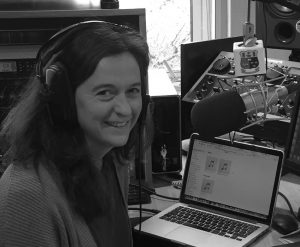
By taking female singer-songwriters in Ireland as an example of a Community of Practice and employing some principles of Participatory Action Research and #TransformDH I am conducting qualitative interviews with practitioners in order to gather information about this particular community . The idea is to approach this from a feminist perspective in a similar way to #Wakingthefeminists and link to others working in the field through #soundingthefeminists and other initiatives.
In this interview which was recently broadcast on Campus Radio UCC 98.3 FM I talk to Maija Sofia about her songwriting influences, her practice and her experience as a woman in the music industry. She also treats us to acoustic versions of two new songs.
I started out by asking her how she described her music and whether she considered herself as sitting in a particular genre. The player below sometimes takes a couple of clicks but it does work
In the second half of the show I invited Maija Sofia to place herself on an imaginary bill alongside some of her songwriting heroes. Here’s the playlist from the show :
- Maija Sofia The Girl Who Pulled the Sun Down
- The Kinks Waterloo Sunset
- Aldous Harding Horizon
- PJ Harvey Rid of Me
- Joanna Newsome Clam, Cockle, Cowrie
- Abigail Joffe The Love We Make
- Kate Bush Moving
- Nico I’ll be your Mirror ( fragment)
Maija Sofia’s music is available to listen to here
These music recordings are licensed for online broadcast and playback under UCC98.3fm
Digital Humanities- what’s that?
I’m at the end of the first semester of my MA in Digital Arts and Humanities at UCC so it seems like a good time to sit back and reflect on what I’m doing here, where its going and what exactly Digital Humanities is. Much time seems to be spent in a debate about this and whilst debate keeps things vibrant it can become a bit exasperating at times to be working in such an all encompassing field. The title Digital Humanist seems to mean different things to different people.
 The fundamental concept is about connecting the Arts and Humanities with Technology. Its also about how we use technology and how technology uses us, about making best use of digital tools for humanities based projects and asking questions about this very process. Its about transformation, democratisation, activism. It begs for definition and at the same time rejects it. The Digital Humanities Manifesto is a frustrating and confusing document with multiple contributors that challenges our conventional way of reading and defining. Whilst being limited in its design – it appears very amateurish , like desk top publishing from the nineties – its refusal to conform to a standard is beginning to make more sense to me the longer I engage with DH.
The fundamental concept is about connecting the Arts and Humanities with Technology. Its also about how we use technology and how technology uses us, about making best use of digital tools for humanities based projects and asking questions about this very process. Its about transformation, democratisation, activism. It begs for definition and at the same time rejects it. The Digital Humanities Manifesto is a frustrating and confusing document with multiple contributors that challenges our conventional way of reading and defining. Whilst being limited in its design – it appears very amateurish , like desk top publishing from the nineties – its refusal to conform to a standard is beginning to make more sense to me the longer I engage with DH.
Can DH really be all things to all people? According to a useful blog I came across by Dr. Amanda Visconti, who writes under the pseudonym Literature Geek the answer to the question ‘Am I DH? ‘ is simply : ‘Yes, if you want to be.’ Her clear and interesting post ‘What, where and how of Digital Humanities’ helped me to move towards some kind of definition of DH.

Over the last few weeks there have been some lightbulb moments, like the announcement in one of our lectures that creativity is fundamental to DH and fresh opinion is valued; Bloom’s taxonomy of learning is turned on its head and Create rather than Remember becomes the guiding principle of teaching and learning.

Another one was waking up to the concept of accessibility in the digital sphere. As an able bodied person I have often considered the issue of access from a buildings perspective but never thought about what I could put in place on myn own website or digital contributions to make my site more universally acceptable. As it happens, embracing a form of universal design and installing a simple word press plug-in WP Accessibility , can kickstart this process quickly. I’m trying it out on this site and now have side toolbar toggles that can alter the text size and background , as well as skip-lines and prompts that remind me to write in Alt text for images. I’m awake to ideas about how I might present my material differently and am considering whether there is a way I could present song in a form that can be enjoyed by deaf people.
The scope of possibility for transformation and activism through DH is another area that interests me , even simply the potential to link up easily with those working on similar or complementary projects. It is inspiring to find that we can link under a banner such as #TransformDH or that I will continue to discover banners, groupings and hashtags that are relevant to my work such as #soundingthefeminists and #theworldislistening.
I have been exposed to a dizzying array of ideas , projects and themes that constitute Digital Humanities. What has jumped out ?
- Key concepts like intersectionality, accessibility and transformation
- Countless academic texts for example about How we read Now, Communities of Practice and treatise on the limitations and possibilities of DH
- Activist and Transform DH projects like The Quipu Project and Mukurtu
- Projects that involve creating new archives or digitising existing archives like the Irish National Archive’s 1901 and 1911 census
- Animating museum and art collections and making them available online like the pan European art database Europeana
- Deep Mapping projects like West Cork Deep Maps Project and Cork Folklore Project’s Memory Map
- A study of Irish feminist hashtivism that I’ve written about in another post.
- Tools such as Omeka, Neatline etc.
- Creative Commons , open source platforms, questions about net neutrality and freedom
On reflection I realise that I have already learnt a lot about what DH is -what I’ve referred to here only scratches the surface. I am now in a position to appreciate the freedom of not being confined or constrained by rigid definitions and to enjoy a sense of possibility and expansion within and without this discipline.
.
Songwriting Women Part 1 : Ciara O’Flynn
I’m hosting a weekly radio show on Thursdays at 12pm on UCC Campus Radio 98.3fm . I’ll be shining the light on women and songwriting and in particular on some local Cork women’s voices. Here’s the first of my interviews with Ciara O’Flynn from the band Pinhole.
Ciara reminisces about growing up around the Cork contemporary music scene and reflects on her influences and chosen playlist which includes Sheela na Gig by PJ Harvey and Cathy Davey’s Snitch. She talks about her songwriting process and themes and we get a pre-listen of some brand new songs from the band’s upcoming album . The show kicks off on a different theme as I play a few jazz numbers inspired by the recent Cork jazz festival.
She’s looking a bit nervous here but you’d never know it from the interview.
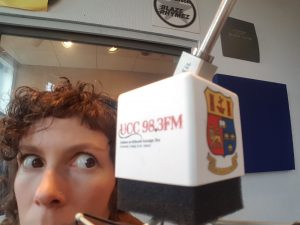 Singer-songwriter Ciara O’Flynn
Singer-songwriter Ciara O’Flynn
